Comparing Health Workforce Planning: Australia and New Zealand
VerifiedAdded on 2023/06/11
|13
|3727
|500
Report
AI Summary
This report provides a comparative analysis of health workforce planning in Australia and New Zealand. It begins with an environmental scan of the health workforce in both countries, highlighting key initiatives, policies, and challenges. In Australia, the focus is on sustainable workforce development, reform, leadership, and policy, while New Zealand emphasizes national coordination through Health Workforce New Zealand (HWNZ), investments in training, and strategic planning. The report also examines data profiles, including registration processes and workforce surveys. Critical issues such as workforce shortages, aging populations, and the need for skilled professionals are discussed. The analysis aims to identify similarities and differences in their approaches to health workforce planning, ultimately informing strategies for effective human resource management in healthcare.
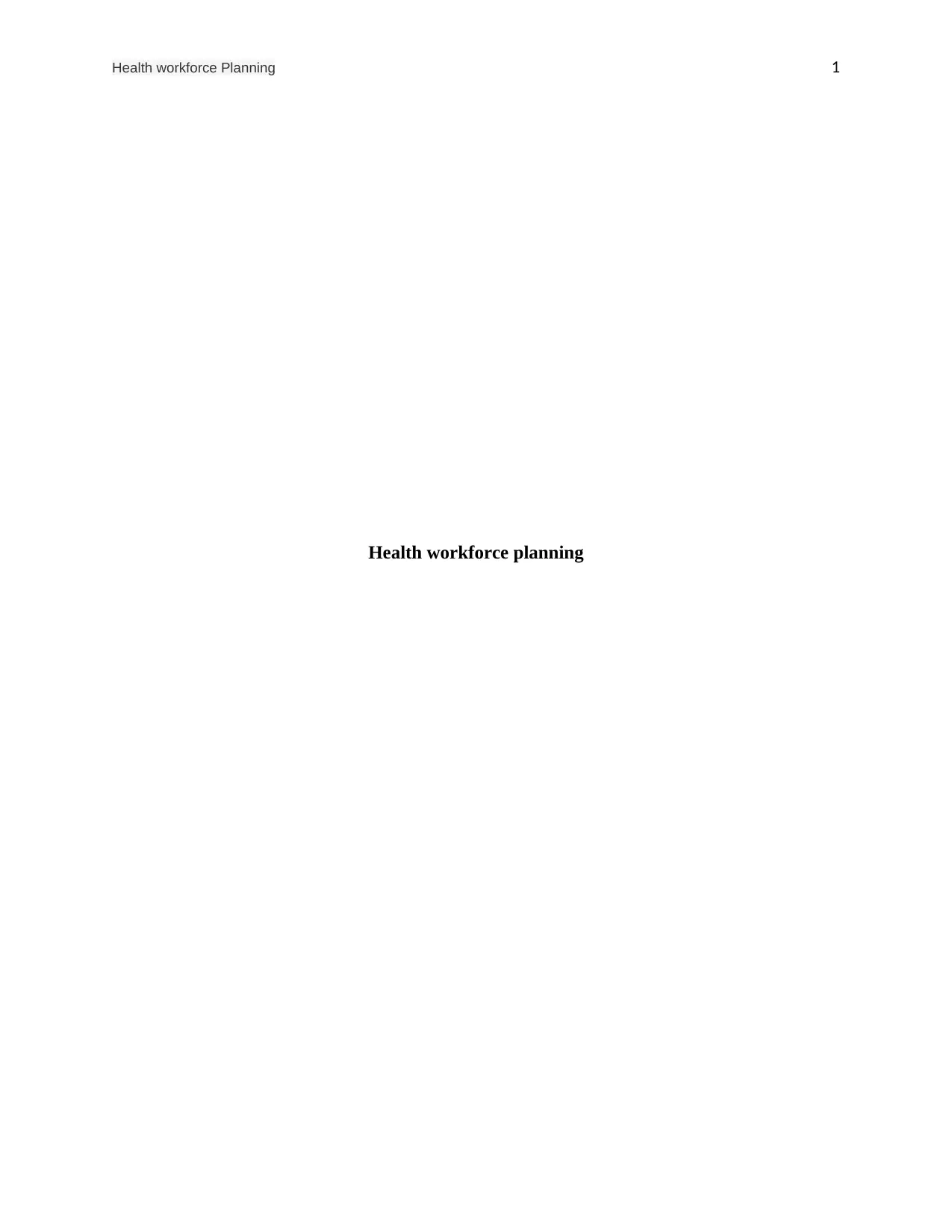
Health workforce Planning 1
Health workforce planning
Health workforce planning
Paraphrase This Document
Need a fresh take? Get an instant paraphrase of this document with our AI Paraphraser
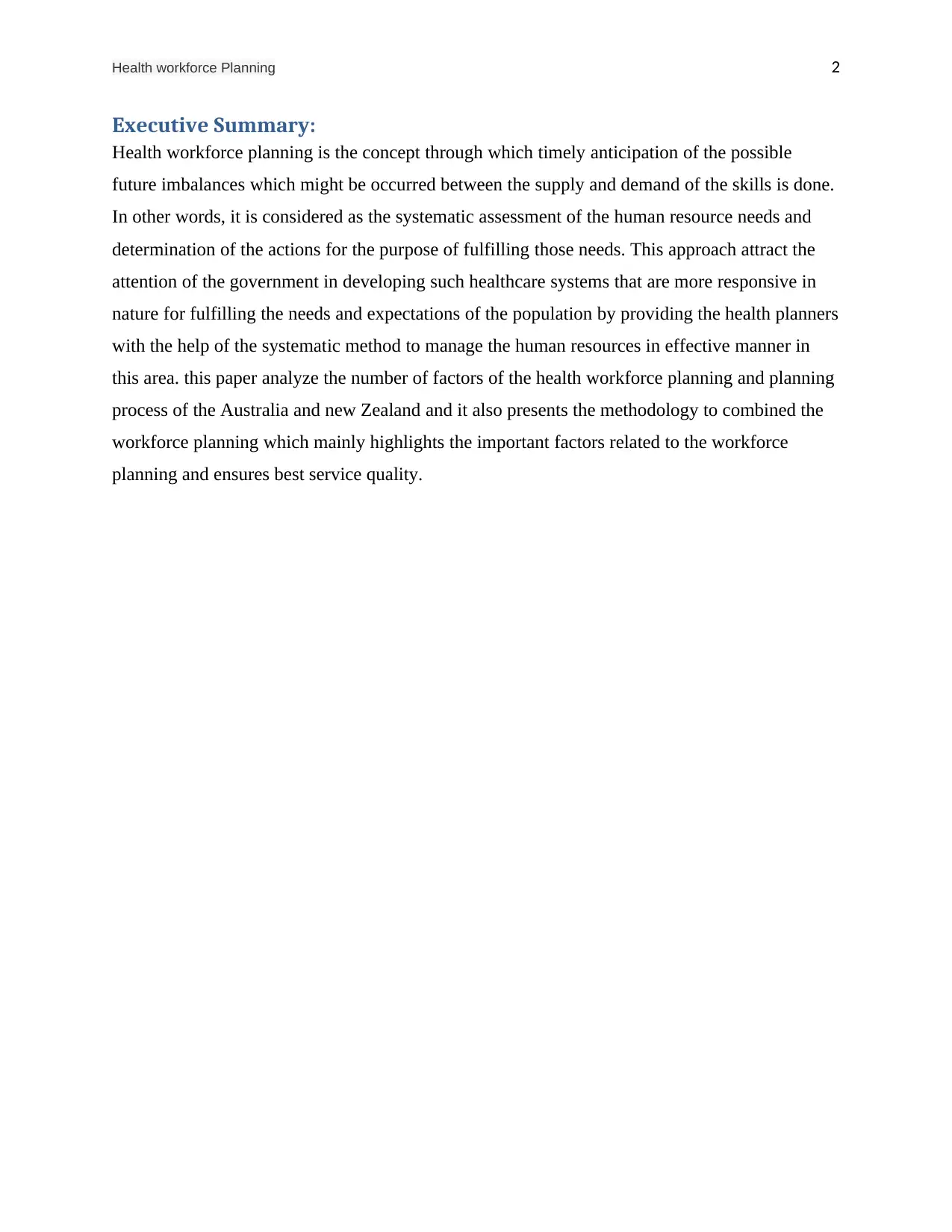
Health workforce Planning 2
Executive Summary:
Health workforce planning is the concept through which timely anticipation of the possible
future imbalances which might be occurred between the supply and demand of the skills is done.
In other words, it is considered as the systematic assessment of the human resource needs and
determination of the actions for the purpose of fulfilling those needs. This approach attract the
attention of the government in developing such healthcare systems that are more responsive in
nature for fulfilling the needs and expectations of the population by providing the health planners
with the help of the systematic method to manage the human resources in effective manner in
this area. this paper analyze the number of factors of the health workforce planning and planning
process of the Australia and new Zealand and it also presents the methodology to combined the
workforce planning which mainly highlights the important factors related to the workforce
planning and ensures best service quality.
Executive Summary:
Health workforce planning is the concept through which timely anticipation of the possible
future imbalances which might be occurred between the supply and demand of the skills is done.
In other words, it is considered as the systematic assessment of the human resource needs and
determination of the actions for the purpose of fulfilling those needs. This approach attract the
attention of the government in developing such healthcare systems that are more responsive in
nature for fulfilling the needs and expectations of the population by providing the health planners
with the help of the systematic method to manage the human resources in effective manner in
this area. this paper analyze the number of factors of the health workforce planning and planning
process of the Australia and new Zealand and it also presents the methodology to combined the
workforce planning which mainly highlights the important factors related to the workforce
planning and ensures best service quality.
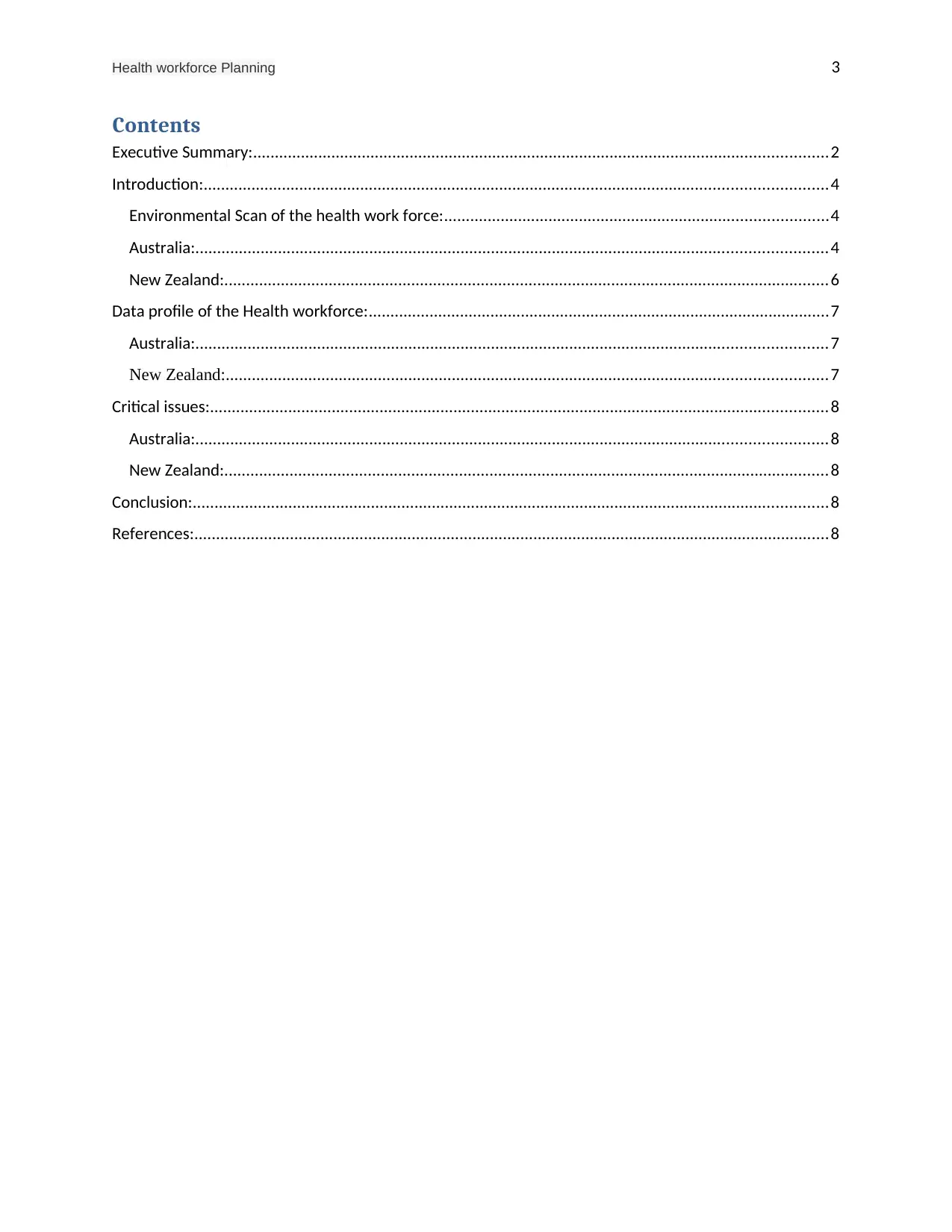
Health workforce Planning 3
Contents
Executive Summary:....................................................................................................................................2
Introduction:...............................................................................................................................................4
Environmental Scan of the health work force:........................................................................................4
Australia:.................................................................................................................................................4
New Zealand:...........................................................................................................................................6
Data profile of the Health workforce:..........................................................................................................7
Australia:.................................................................................................................................................7
New Zealand:..........................................................................................................................................7
Critical issues:..............................................................................................................................................8
Australia:.................................................................................................................................................8
New Zealand:...........................................................................................................................................8
Conclusion:..................................................................................................................................................8
References:..................................................................................................................................................8
Contents
Executive Summary:....................................................................................................................................2
Introduction:...............................................................................................................................................4
Environmental Scan of the health work force:........................................................................................4
Australia:.................................................................................................................................................4
New Zealand:...........................................................................................................................................6
Data profile of the Health workforce:..........................................................................................................7
Australia:.................................................................................................................................................7
New Zealand:..........................................................................................................................................7
Critical issues:..............................................................................................................................................8
Australia:.................................................................................................................................................8
New Zealand:...........................................................................................................................................8
Conclusion:..................................................................................................................................................8
References:..................................................................................................................................................8
⊘ This is a preview!⊘
Do you want full access?
Subscribe today to unlock all pages.

Trusted by 1+ million students worldwide
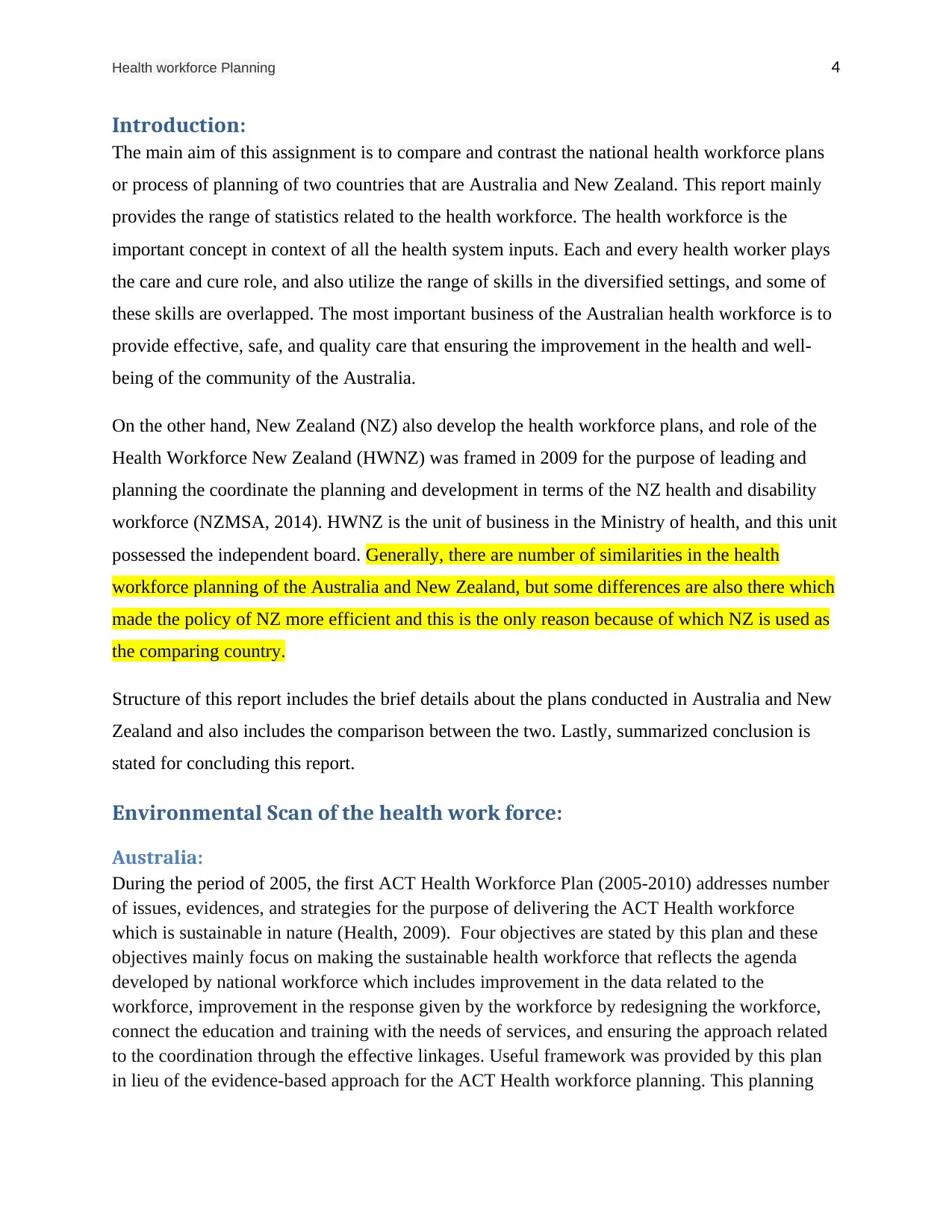
Health workforce Planning 4
Introduction:
The main aim of this assignment is to compare and contrast the national health workforce plans
or process of planning of two countries that are Australia and New Zealand. This report mainly
provides the range of statistics related to the health workforce. The health workforce is the
important concept in context of all the health system inputs. Each and every health worker plays
the care and cure role, and also utilize the range of skills in the diversified settings, and some of
these skills are overlapped. The most important business of the Australian health workforce is to
provide effective, safe, and quality care that ensuring the improvement in the health and well-
being of the community of the Australia.
On the other hand, New Zealand (NZ) also develop the health workforce plans, and role of the
Health Workforce New Zealand (HWNZ) was framed in 2009 for the purpose of leading and
planning the coordinate the planning and development in terms of the NZ health and disability
workforce (NZMSA, 2014). HWNZ is the unit of business in the Ministry of health, and this unit
possessed the independent board. Generally, there are number of similarities in the health
workforce planning of the Australia and New Zealand, but some differences are also there which
made the policy of NZ more efficient and this is the only reason because of which NZ is used as
the comparing country.
Structure of this report includes the brief details about the plans conducted in Australia and New
Zealand and also includes the comparison between the two. Lastly, summarized conclusion is
stated for concluding this report.
Environmental Scan of the health work force:
Australia:
During the period of 2005, the first ACT Health Workforce Plan (2005-2010) addresses number
of issues, evidences, and strategies for the purpose of delivering the ACT Health workforce
which is sustainable in nature (Health, 2009). Four objectives are stated by this plan and these
objectives mainly focus on making the sustainable health workforce that reflects the agenda
developed by national workforce which includes improvement in the data related to the
workforce, improvement in the response given by the workforce by redesigning the workforce,
connect the education and training with the needs of services, and ensuring the approach related
to the coordination through the effective linkages. Useful framework was provided by this plan
in lieu of the evidence-based approach for the ACT Health workforce planning. This planning
Introduction:
The main aim of this assignment is to compare and contrast the national health workforce plans
or process of planning of two countries that are Australia and New Zealand. This report mainly
provides the range of statistics related to the health workforce. The health workforce is the
important concept in context of all the health system inputs. Each and every health worker plays
the care and cure role, and also utilize the range of skills in the diversified settings, and some of
these skills are overlapped. The most important business of the Australian health workforce is to
provide effective, safe, and quality care that ensuring the improvement in the health and well-
being of the community of the Australia.
On the other hand, New Zealand (NZ) also develop the health workforce plans, and role of the
Health Workforce New Zealand (HWNZ) was framed in 2009 for the purpose of leading and
planning the coordinate the planning and development in terms of the NZ health and disability
workforce (NZMSA, 2014). HWNZ is the unit of business in the Ministry of health, and this unit
possessed the independent board. Generally, there are number of similarities in the health
workforce planning of the Australia and New Zealand, but some differences are also there which
made the policy of NZ more efficient and this is the only reason because of which NZ is used as
the comparing country.
Structure of this report includes the brief details about the plans conducted in Australia and New
Zealand and also includes the comparison between the two. Lastly, summarized conclusion is
stated for concluding this report.
Environmental Scan of the health work force:
Australia:
During the period of 2005, the first ACT Health Workforce Plan (2005-2010) addresses number
of issues, evidences, and strategies for the purpose of delivering the ACT Health workforce
which is sustainable in nature (Health, 2009). Four objectives are stated by this plan and these
objectives mainly focus on making the sustainable health workforce that reflects the agenda
developed by national workforce which includes improvement in the data related to the
workforce, improvement in the response given by the workforce by redesigning the workforce,
connect the education and training with the needs of services, and ensuring the approach related
to the coordination through the effective linkages. Useful framework was provided by this plan
in lieu of the evidence-based approach for the ACT Health workforce planning. This planning
Paraphrase This Document
Need a fresh take? Get an instant paraphrase of this document with our AI Paraphraser
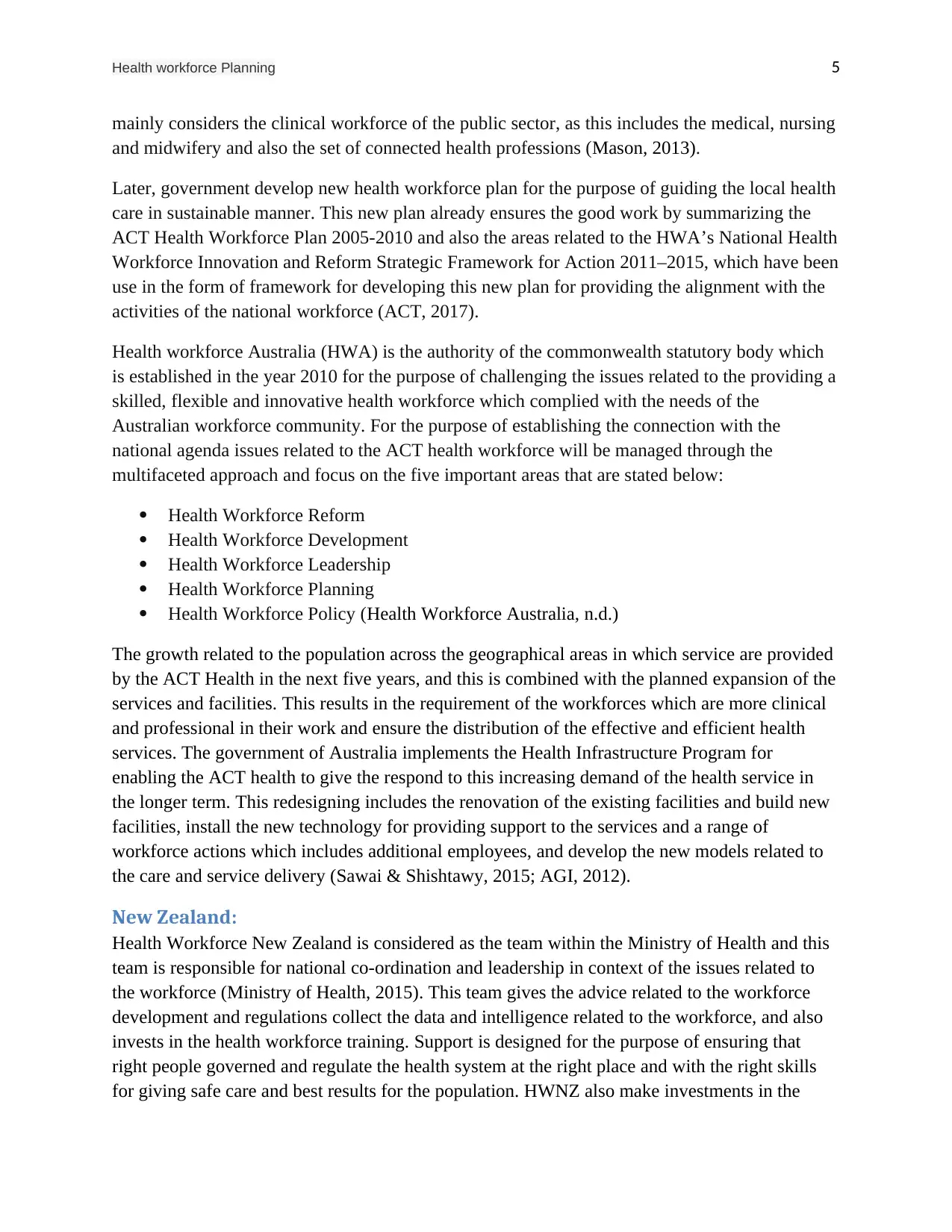
Health workforce Planning 5
mainly considers the clinical workforce of the public sector, as this includes the medical, nursing
and midwifery and also the set of connected health professions (Mason, 2013).
Later, government develop new health workforce plan for the purpose of guiding the local health
care in sustainable manner. This new plan already ensures the good work by summarizing the
ACT Health Workforce Plan 2005-2010 and also the areas related to the HWA’s National Health
Workforce Innovation and Reform Strategic Framework for Action 2011–2015, which have been
use in the form of framework for developing this new plan for providing the alignment with the
activities of the national workforce (ACT, 2017).
Health workforce Australia (HWA) is the authority of the commonwealth statutory body which
is established in the year 2010 for the purpose of challenging the issues related to the providing a
skilled, flexible and innovative health workforce which complied with the needs of the
Australian workforce community. For the purpose of establishing the connection with the
national agenda issues related to the ACT health workforce will be managed through the
multifaceted approach and focus on the five important areas that are stated below:
Health Workforce Reform
Health Workforce Development
Health Workforce Leadership
Health Workforce Planning
Health Workforce Policy (Health Workforce Australia, n.d.)
The growth related to the population across the geographical areas in which service are provided
by the ACT Health in the next five years, and this is combined with the planned expansion of the
services and facilities. This results in the requirement of the workforces which are more clinical
and professional in their work and ensure the distribution of the effective and efficient health
services. The government of Australia implements the Health Infrastructure Program for
enabling the ACT health to give the respond to this increasing demand of the health service in
the longer term. This redesigning includes the renovation of the existing facilities and build new
facilities, install the new technology for providing support to the services and a range of
workforce actions which includes additional employees, and develop the new models related to
the care and service delivery (Sawai & Shishtawy, 2015; AGI, 2012).
New Zealand:
Health Workforce New Zealand is considered as the team within the Ministry of Health and this
team is responsible for national co-ordination and leadership in context of the issues related to
the workforce (Ministry of Health, 2015). This team gives the advice related to the workforce
development and regulations collect the data and intelligence related to the workforce, and also
invests in the health workforce training. Support is designed for the purpose of ensuring that
right people governed and regulate the health system at the right place and with the right skills
for giving safe care and best results for the population. HWNZ also make investments in the
mainly considers the clinical workforce of the public sector, as this includes the medical, nursing
and midwifery and also the set of connected health professions (Mason, 2013).
Later, government develop new health workforce plan for the purpose of guiding the local health
care in sustainable manner. This new plan already ensures the good work by summarizing the
ACT Health Workforce Plan 2005-2010 and also the areas related to the HWA’s National Health
Workforce Innovation and Reform Strategic Framework for Action 2011–2015, which have been
use in the form of framework for developing this new plan for providing the alignment with the
activities of the national workforce (ACT, 2017).
Health workforce Australia (HWA) is the authority of the commonwealth statutory body which
is established in the year 2010 for the purpose of challenging the issues related to the providing a
skilled, flexible and innovative health workforce which complied with the needs of the
Australian workforce community. For the purpose of establishing the connection with the
national agenda issues related to the ACT health workforce will be managed through the
multifaceted approach and focus on the five important areas that are stated below:
Health Workforce Reform
Health Workforce Development
Health Workforce Leadership
Health Workforce Planning
Health Workforce Policy (Health Workforce Australia, n.d.)
The growth related to the population across the geographical areas in which service are provided
by the ACT Health in the next five years, and this is combined with the planned expansion of the
services and facilities. This results in the requirement of the workforces which are more clinical
and professional in their work and ensure the distribution of the effective and efficient health
services. The government of Australia implements the Health Infrastructure Program for
enabling the ACT health to give the respond to this increasing demand of the health service in
the longer term. This redesigning includes the renovation of the existing facilities and build new
facilities, install the new technology for providing support to the services and a range of
workforce actions which includes additional employees, and develop the new models related to
the care and service delivery (Sawai & Shishtawy, 2015; AGI, 2012).
New Zealand:
Health Workforce New Zealand is considered as the team within the Ministry of Health and this
team is responsible for national co-ordination and leadership in context of the issues related to
the workforce (Ministry of Health, 2015). This team gives the advice related to the workforce
development and regulations collect the data and intelligence related to the workforce, and also
invests in the health workforce training. Support is designed for the purpose of ensuring that
right people governed and regulate the health system at the right place and with the right skills
for giving safe care and best results for the population. HWNZ also make investments in the
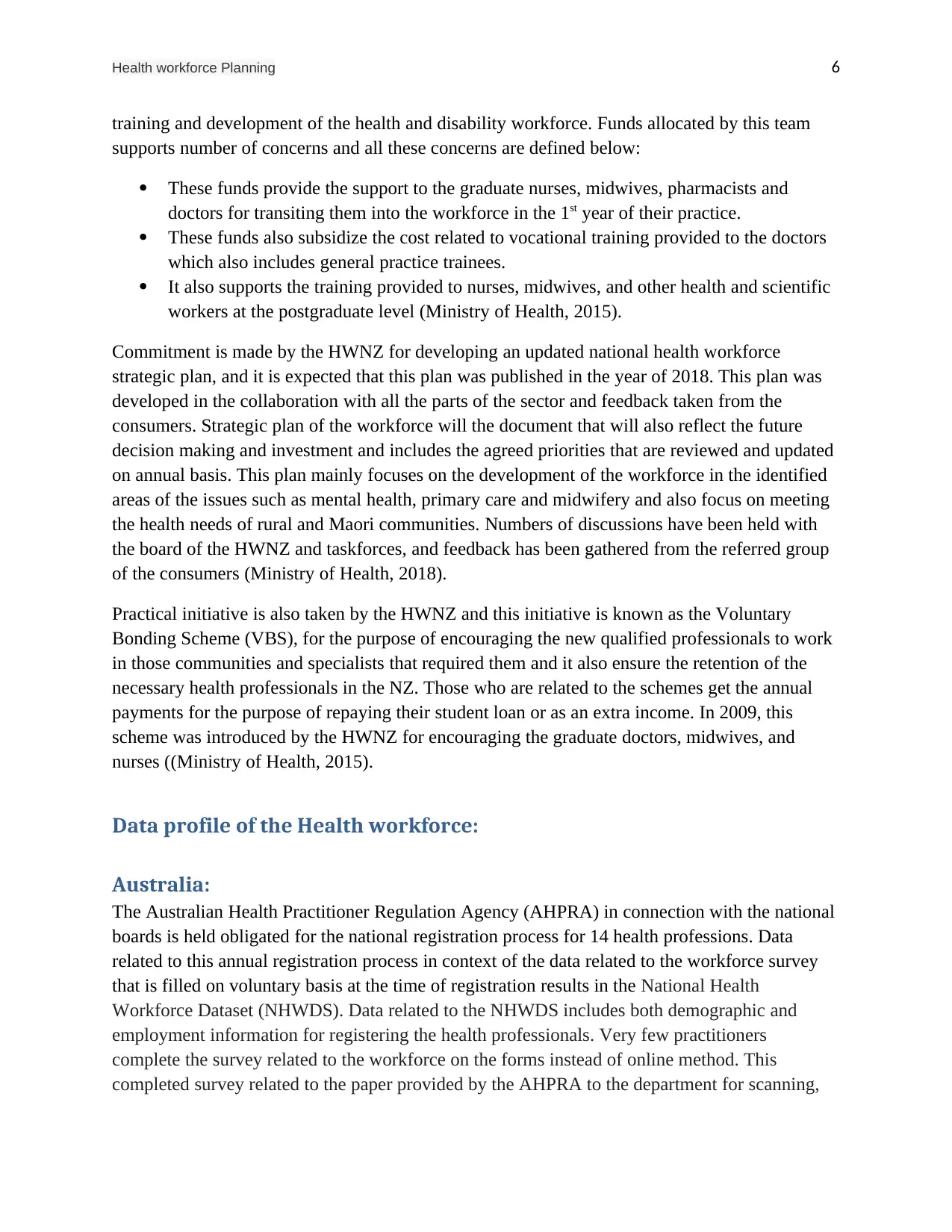
Health workforce Planning 6
training and development of the health and disability workforce. Funds allocated by this team
supports number of concerns and all these concerns are defined below:
These funds provide the support to the graduate nurses, midwives, pharmacists and
doctors for transiting them into the workforce in the 1st year of their practice.
These funds also subsidize the cost related to vocational training provided to the doctors
which also includes general practice trainees.
It also supports the training provided to nurses, midwives, and other health and scientific
workers at the postgraduate level (Ministry of Health, 2015).
Commitment is made by the HWNZ for developing an updated national health workforce
strategic plan, and it is expected that this plan was published in the year of 2018. This plan was
developed in the collaboration with all the parts of the sector and feedback taken from the
consumers. Strategic plan of the workforce will the document that will also reflect the future
decision making and investment and includes the agreed priorities that are reviewed and updated
on annual basis. This plan mainly focuses on the development of the workforce in the identified
areas of the issues such as mental health, primary care and midwifery and also focus on meeting
the health needs of rural and Maori communities. Numbers of discussions have been held with
the board of the HWNZ and taskforces, and feedback has been gathered from the referred group
of the consumers (Ministry of Health, 2018).
Practical initiative is also taken by the HWNZ and this initiative is known as the Voluntary
Bonding Scheme (VBS), for the purpose of encouraging the new qualified professionals to work
in those communities and specialists that required them and it also ensure the retention of the
necessary health professionals in the NZ. Those who are related to the schemes get the annual
payments for the purpose of repaying their student loan or as an extra income. In 2009, this
scheme was introduced by the HWNZ for encouraging the graduate doctors, midwives, and
nurses ((Ministry of Health, 2015).
Data profile of the Health workforce:
Australia:
The Australian Health Practitioner Regulation Agency (AHPRA) in connection with the national
boards is held obligated for the national registration process for 14 health professions. Data
related to this annual registration process in context of the data related to the workforce survey
that is filled on voluntary basis at the time of registration results in the National Health
Workforce Dataset (NHWDS). Data related to the NHWDS includes both demographic and
employment information for registering the health professionals. Very few practitioners
complete the survey related to the workforce on the forms instead of online method. This
completed survey related to the paper provided by the AHPRA to the department for scanning,
training and development of the health and disability workforce. Funds allocated by this team
supports number of concerns and all these concerns are defined below:
These funds provide the support to the graduate nurses, midwives, pharmacists and
doctors for transiting them into the workforce in the 1st year of their practice.
These funds also subsidize the cost related to vocational training provided to the doctors
which also includes general practice trainees.
It also supports the training provided to nurses, midwives, and other health and scientific
workers at the postgraduate level (Ministry of Health, 2015).
Commitment is made by the HWNZ for developing an updated national health workforce
strategic plan, and it is expected that this plan was published in the year of 2018. This plan was
developed in the collaboration with all the parts of the sector and feedback taken from the
consumers. Strategic plan of the workforce will the document that will also reflect the future
decision making and investment and includes the agreed priorities that are reviewed and updated
on annual basis. This plan mainly focuses on the development of the workforce in the identified
areas of the issues such as mental health, primary care and midwifery and also focus on meeting
the health needs of rural and Maori communities. Numbers of discussions have been held with
the board of the HWNZ and taskforces, and feedback has been gathered from the referred group
of the consumers (Ministry of Health, 2018).
Practical initiative is also taken by the HWNZ and this initiative is known as the Voluntary
Bonding Scheme (VBS), for the purpose of encouraging the new qualified professionals to work
in those communities and specialists that required them and it also ensure the retention of the
necessary health professionals in the NZ. Those who are related to the schemes get the annual
payments for the purpose of repaying their student loan or as an extra income. In 2009, this
scheme was introduced by the HWNZ for encouraging the graduate doctors, midwives, and
nurses ((Ministry of Health, 2015).
Data profile of the Health workforce:
Australia:
The Australian Health Practitioner Regulation Agency (AHPRA) in connection with the national
boards is held obligated for the national registration process for 14 health professions. Data
related to this annual registration process in context of the data related to the workforce survey
that is filled on voluntary basis at the time of registration results in the National Health
Workforce Dataset (NHWDS). Data related to the NHWDS includes both demographic and
employment information for registering the health professionals. Very few practitioners
complete the survey related to the workforce on the forms instead of online method. This
completed survey related to the paper provided by the AHPRA to the department for scanning,
⊘ This is a preview!⊘
Do you want full access?
Subscribe today to unlock all pages.

Trusted by 1+ million students worldwide
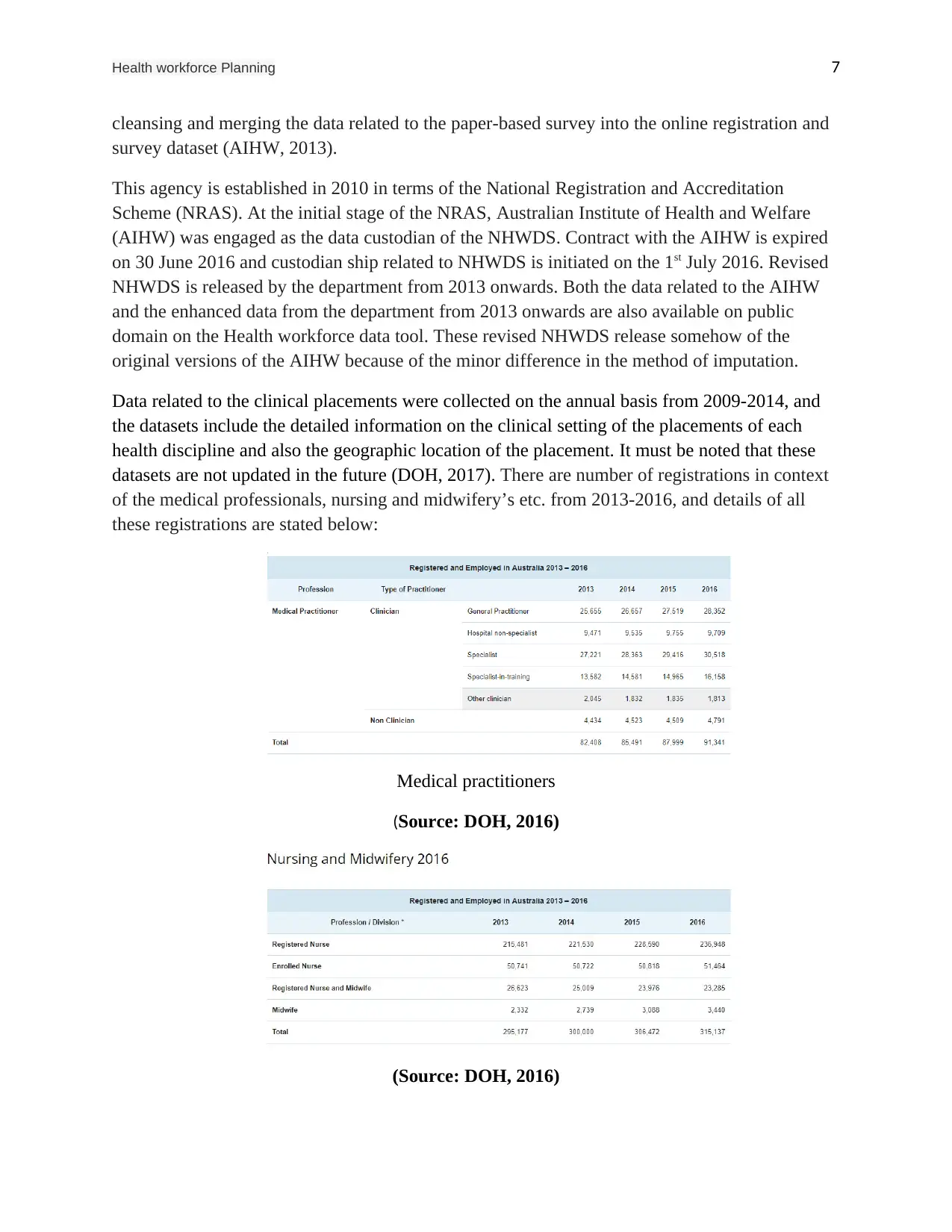
Health workforce Planning 7
cleansing and merging the data related to the paper-based survey into the online registration and
survey dataset (AIHW, 2013).
This agency is established in 2010 in terms of the National Registration and Accreditation
Scheme (NRAS). At the initial stage of the NRAS, Australian Institute of Health and Welfare
(AIHW) was engaged as the data custodian of the NHWDS. Contract with the AIHW is expired
on 30 June 2016 and custodian ship related to NHWDS is initiated on the 1st July 2016. Revised
NHWDS is released by the department from 2013 onwards. Both the data related to the AIHW
and the enhanced data from the department from 2013 onwards are also available on public
domain on the Health workforce data tool. These revised NHWDS release somehow of the
original versions of the AIHW because of the minor difference in the method of imputation.
Data related to the clinical placements were collected on the annual basis from 2009-2014, and
the datasets include the detailed information on the clinical setting of the placements of each
health discipline and also the geographic location of the placement. It must be noted that these
datasets are not updated in the future (DOH, 2017). There are number of registrations in context
of the medical professionals, nursing and midwifery’s etc. from 2013-2016, and details of all
these registrations are stated below:
Medical practitioners
(Source: DOH, 2016)
(Source: DOH, 2016)
cleansing and merging the data related to the paper-based survey into the online registration and
survey dataset (AIHW, 2013).
This agency is established in 2010 in terms of the National Registration and Accreditation
Scheme (NRAS). At the initial stage of the NRAS, Australian Institute of Health and Welfare
(AIHW) was engaged as the data custodian of the NHWDS. Contract with the AIHW is expired
on 30 June 2016 and custodian ship related to NHWDS is initiated on the 1st July 2016. Revised
NHWDS is released by the department from 2013 onwards. Both the data related to the AIHW
and the enhanced data from the department from 2013 onwards are also available on public
domain on the Health workforce data tool. These revised NHWDS release somehow of the
original versions of the AIHW because of the minor difference in the method of imputation.
Data related to the clinical placements were collected on the annual basis from 2009-2014, and
the datasets include the detailed information on the clinical setting of the placements of each
health discipline and also the geographic location of the placement. It must be noted that these
datasets are not updated in the future (DOH, 2017). There are number of registrations in context
of the medical professionals, nursing and midwifery’s etc. from 2013-2016, and details of all
these registrations are stated below:
Medical practitioners
(Source: DOH, 2016)
(Source: DOH, 2016)
Paraphrase This Document
Need a fresh take? Get an instant paraphrase of this document with our AI Paraphraser
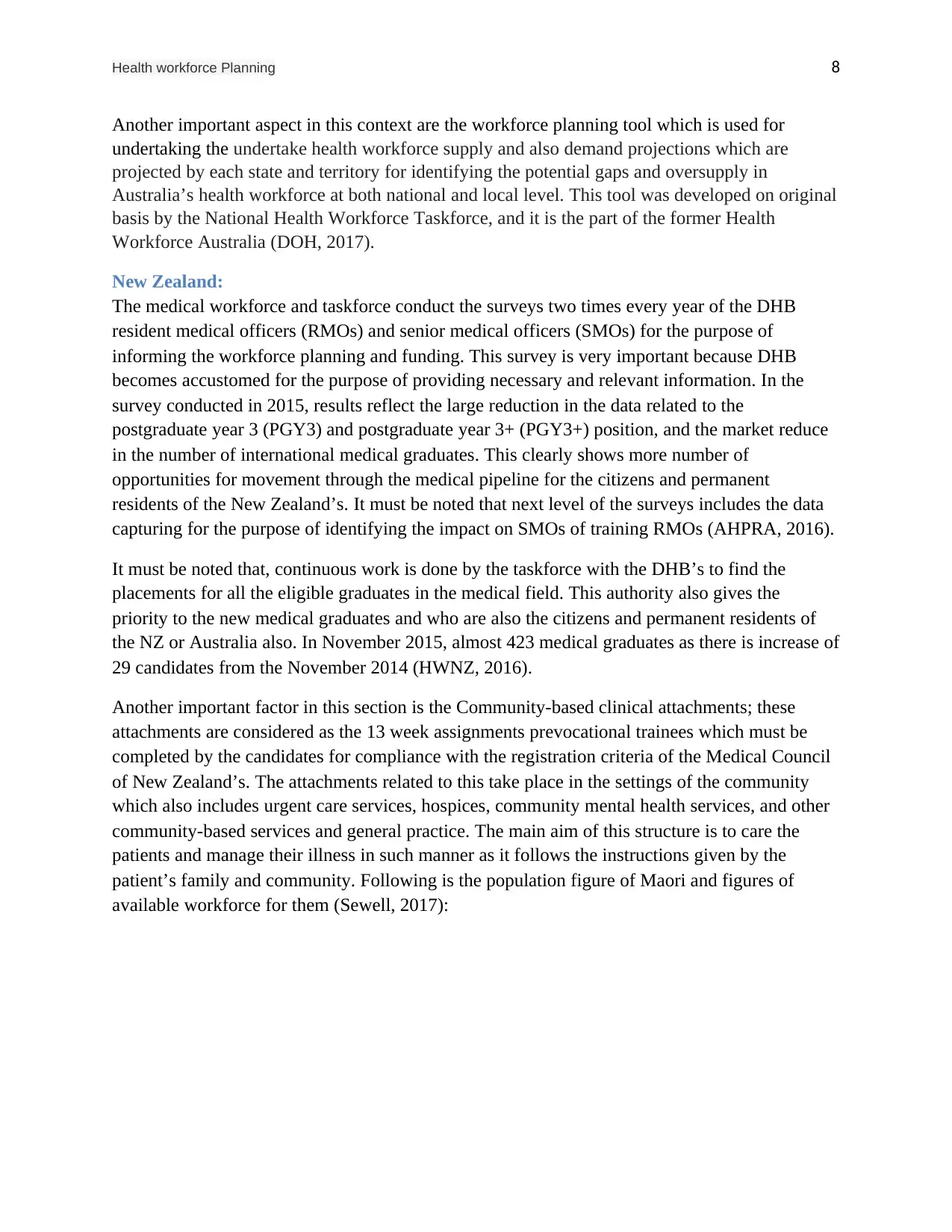
Health workforce Planning 8
Another important aspect in this context are the workforce planning tool which is used for
undertaking the undertake health workforce supply and also demand projections which are
projected by each state and territory for identifying the potential gaps and oversupply in
Australia’s health workforce at both national and local level. This tool was developed on original
basis by the National Health Workforce Taskforce, and it is the part of the former Health
Workforce Australia (DOH, 2017).
New Zealand:
The medical workforce and taskforce conduct the surveys two times every year of the DHB
resident medical officers (RMOs) and senior medical officers (SMOs) for the purpose of
informing the workforce planning and funding. This survey is very important because DHB
becomes accustomed for the purpose of providing necessary and relevant information. In the
survey conducted in 2015, results reflect the large reduction in the data related to the
postgraduate year 3 (PGY3) and postgraduate year 3+ (PGY3+) position, and the market reduce
in the number of international medical graduates. This clearly shows more number of
opportunities for movement through the medical pipeline for the citizens and permanent
residents of the New Zealand’s. It must be noted that next level of the surveys includes the data
capturing for the purpose of identifying the impact on SMOs of training RMOs (AHPRA, 2016).
It must be noted that, continuous work is done by the taskforce with the DHB’s to find the
placements for all the eligible graduates in the medical field. This authority also gives the
priority to the new medical graduates and who are also the citizens and permanent residents of
the NZ or Australia also. In November 2015, almost 423 medical graduates as there is increase of
29 candidates from the November 2014 (HWNZ, 2016).
Another important factor in this section is the Community-based clinical attachments; these
attachments are considered as the 13 week assignments prevocational trainees which must be
completed by the candidates for compliance with the registration criteria of the Medical Council
of New Zealand’s. The attachments related to this take place in the settings of the community
which also includes urgent care services, hospices, community mental health services, and other
community-based services and general practice. The main aim of this structure is to care the
patients and manage their illness in such manner as it follows the instructions given by the
patient’s family and community. Following is the population figure of Maori and figures of
available workforce for them (Sewell, 2017):
Another important aspect in this context are the workforce planning tool which is used for
undertaking the undertake health workforce supply and also demand projections which are
projected by each state and territory for identifying the potential gaps and oversupply in
Australia’s health workforce at both national and local level. This tool was developed on original
basis by the National Health Workforce Taskforce, and it is the part of the former Health
Workforce Australia (DOH, 2017).
New Zealand:
The medical workforce and taskforce conduct the surveys two times every year of the DHB
resident medical officers (RMOs) and senior medical officers (SMOs) for the purpose of
informing the workforce planning and funding. This survey is very important because DHB
becomes accustomed for the purpose of providing necessary and relevant information. In the
survey conducted in 2015, results reflect the large reduction in the data related to the
postgraduate year 3 (PGY3) and postgraduate year 3+ (PGY3+) position, and the market reduce
in the number of international medical graduates. This clearly shows more number of
opportunities for movement through the medical pipeline for the citizens and permanent
residents of the New Zealand’s. It must be noted that next level of the surveys includes the data
capturing for the purpose of identifying the impact on SMOs of training RMOs (AHPRA, 2016).
It must be noted that, continuous work is done by the taskforce with the DHB’s to find the
placements for all the eligible graduates in the medical field. This authority also gives the
priority to the new medical graduates and who are also the citizens and permanent residents of
the NZ or Australia also. In November 2015, almost 423 medical graduates as there is increase of
29 candidates from the November 2014 (HWNZ, 2016).
Another important factor in this section is the Community-based clinical attachments; these
attachments are considered as the 13 week assignments prevocational trainees which must be
completed by the candidates for compliance with the registration criteria of the Medical Council
of New Zealand’s. The attachments related to this take place in the settings of the community
which also includes urgent care services, hospices, community mental health services, and other
community-based services and general practice. The main aim of this structure is to care the
patients and manage their illness in such manner as it follows the instructions given by the
patient’s family and community. Following is the population figure of Maori and figures of
available workforce for them (Sewell, 2017):
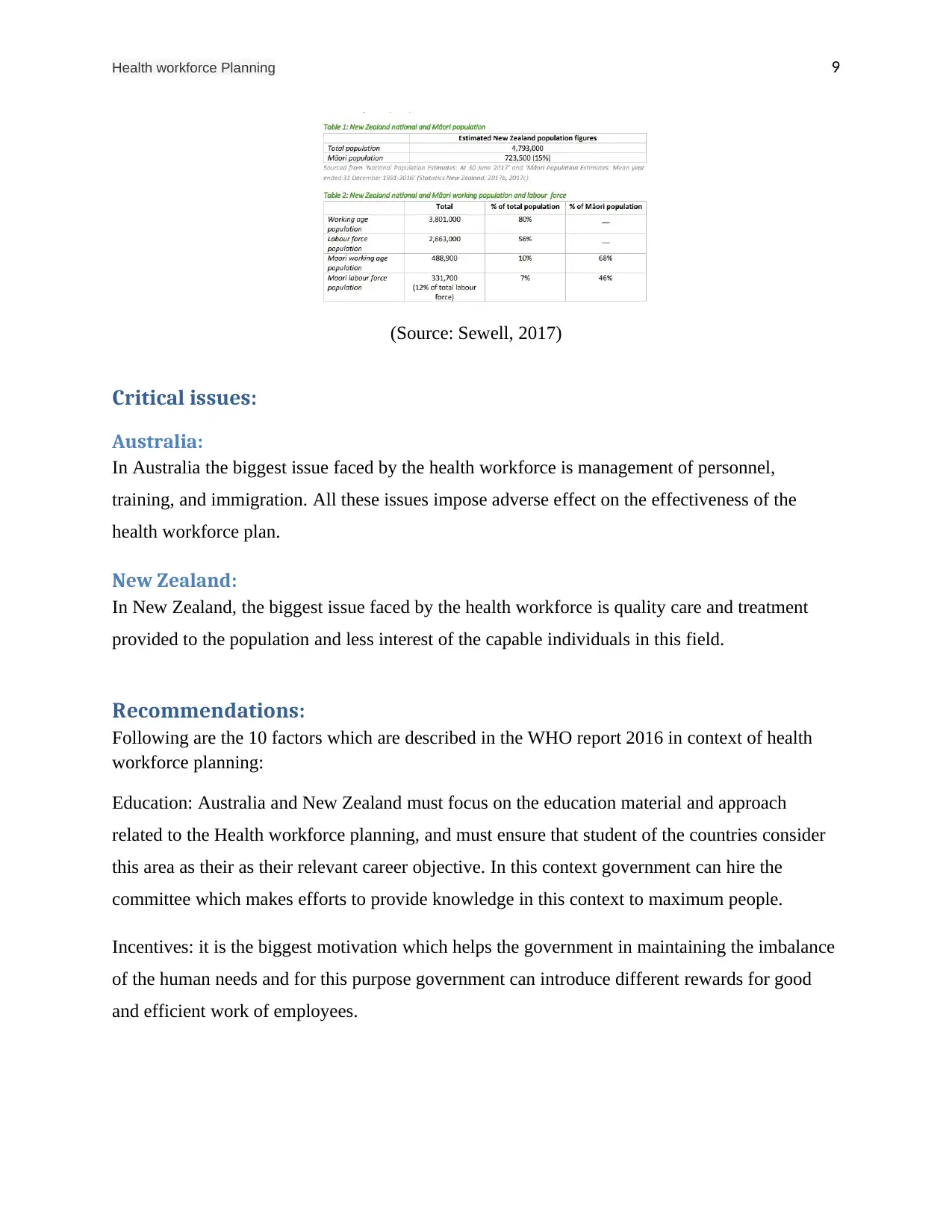
Health workforce Planning 9
(Source: Sewell, 2017)
Critical issues:
Australia:
In Australia the biggest issue faced by the health workforce is management of personnel,
training, and immigration. All these issues impose adverse effect on the effectiveness of the
health workforce plan.
New Zealand:
In New Zealand, the biggest issue faced by the health workforce is quality care and treatment
provided to the population and less interest of the capable individuals in this field.
Recommendations:
Following are the 10 factors which are described in the WHO report 2016 in context of health
workforce planning:
Education: Australia and New Zealand must focus on the education material and approach
related to the Health workforce planning, and must ensure that student of the countries consider
this area as their as their relevant career objective. In this context government can hire the
committee which makes efforts to provide knowledge in this context to maximum people.
Incentives: it is the biggest motivation which helps the government in maintaining the imbalance
of the human needs and for this purpose government can introduce different rewards for good
and efficient work of employees.
(Source: Sewell, 2017)
Critical issues:
Australia:
In Australia the biggest issue faced by the health workforce is management of personnel,
training, and immigration. All these issues impose adverse effect on the effectiveness of the
health workforce plan.
New Zealand:
In New Zealand, the biggest issue faced by the health workforce is quality care and treatment
provided to the population and less interest of the capable individuals in this field.
Recommendations:
Following are the 10 factors which are described in the WHO report 2016 in context of health
workforce planning:
Education: Australia and New Zealand must focus on the education material and approach
related to the Health workforce planning, and must ensure that student of the countries consider
this area as their as their relevant career objective. In this context government can hire the
committee which makes efforts to provide knowledge in this context to maximum people.
Incentives: it is the biggest motivation which helps the government in maintaining the imbalance
of the human needs and for this purpose government can introduce different rewards for good
and efficient work of employees.
⊘ This is a preview!⊘
Do you want full access?
Subscribe today to unlock all pages.

Trusted by 1+ million students worldwide
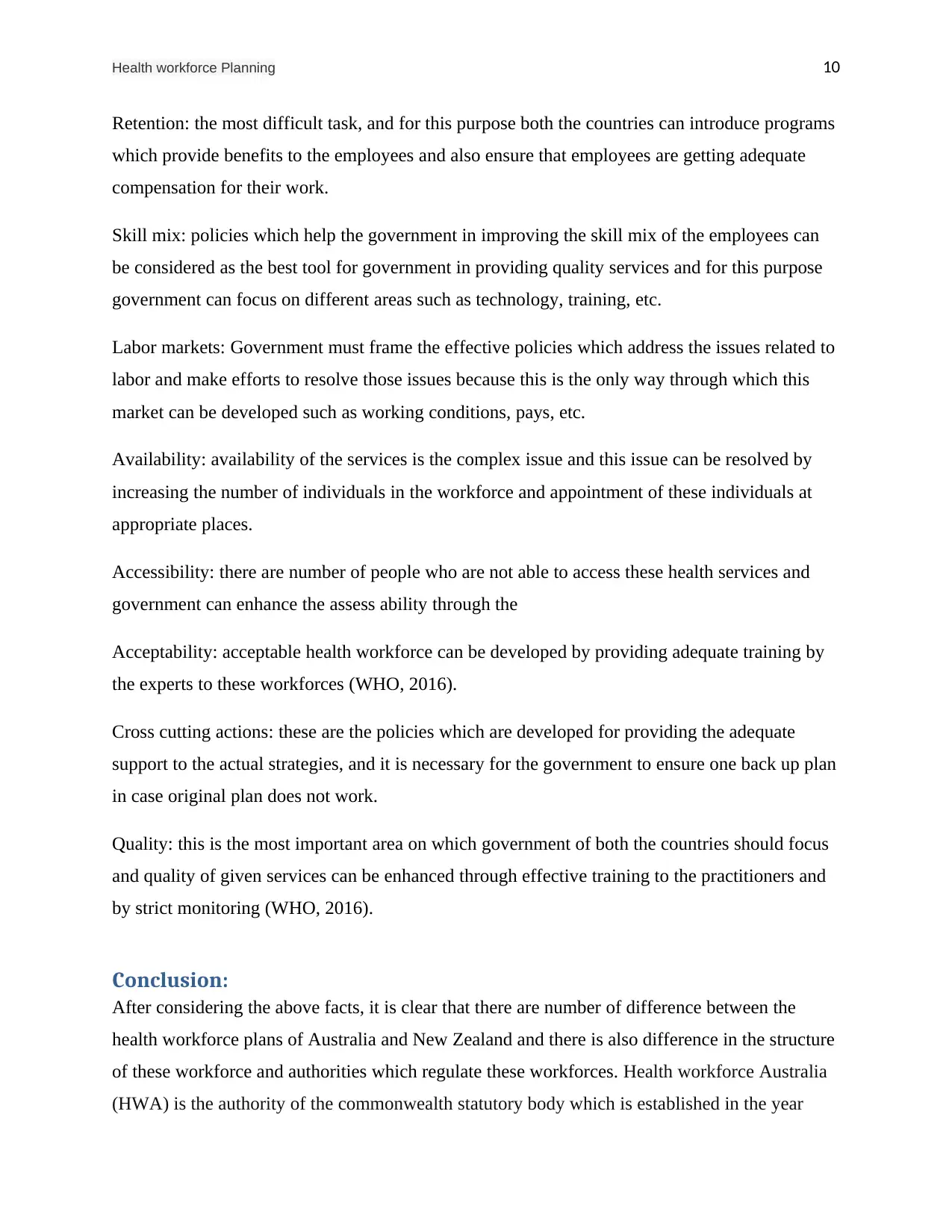
Health workforce Planning 10
Retention: the most difficult task, and for this purpose both the countries can introduce programs
which provide benefits to the employees and also ensure that employees are getting adequate
compensation for their work.
Skill mix: policies which help the government in improving the skill mix of the employees can
be considered as the best tool for government in providing quality services and for this purpose
government can focus on different areas such as technology, training, etc.
Labor markets: Government must frame the effective policies which address the issues related to
labor and make efforts to resolve those issues because this is the only way through which this
market can be developed such as working conditions, pays, etc.
Availability: availability of the services is the complex issue and this issue can be resolved by
increasing the number of individuals in the workforce and appointment of these individuals at
appropriate places.
Accessibility: there are number of people who are not able to access these health services and
government can enhance the assess ability through the
Acceptability: acceptable health workforce can be developed by providing adequate training by
the experts to these workforces (WHO, 2016).
Cross cutting actions: these are the policies which are developed for providing the adequate
support to the actual strategies, and it is necessary for the government to ensure one back up plan
in case original plan does not work.
Quality: this is the most important area on which government of both the countries should focus
and quality of given services can be enhanced through effective training to the practitioners and
by strict monitoring (WHO, 2016).
Conclusion:
After considering the above facts, it is clear that there are number of difference between the
health workforce plans of Australia and New Zealand and there is also difference in the structure
of these workforce and authorities which regulate these workforces. Health workforce Australia
(HWA) is the authority of the commonwealth statutory body which is established in the year
Retention: the most difficult task, and for this purpose both the countries can introduce programs
which provide benefits to the employees and also ensure that employees are getting adequate
compensation for their work.
Skill mix: policies which help the government in improving the skill mix of the employees can
be considered as the best tool for government in providing quality services and for this purpose
government can focus on different areas such as technology, training, etc.
Labor markets: Government must frame the effective policies which address the issues related to
labor and make efforts to resolve those issues because this is the only way through which this
market can be developed such as working conditions, pays, etc.
Availability: availability of the services is the complex issue and this issue can be resolved by
increasing the number of individuals in the workforce and appointment of these individuals at
appropriate places.
Accessibility: there are number of people who are not able to access these health services and
government can enhance the assess ability through the
Acceptability: acceptable health workforce can be developed by providing adequate training by
the experts to these workforces (WHO, 2016).
Cross cutting actions: these are the policies which are developed for providing the adequate
support to the actual strategies, and it is necessary for the government to ensure one back up plan
in case original plan does not work.
Quality: this is the most important area on which government of both the countries should focus
and quality of given services can be enhanced through effective training to the practitioners and
by strict monitoring (WHO, 2016).
Conclusion:
After considering the above facts, it is clear that there are number of difference between the
health workforce plans of Australia and New Zealand and there is also difference in the structure
of these workforce and authorities which regulate these workforces. Health workforce Australia
(HWA) is the authority of the commonwealth statutory body which is established in the year
Paraphrase This Document
Need a fresh take? Get an instant paraphrase of this document with our AI Paraphraser
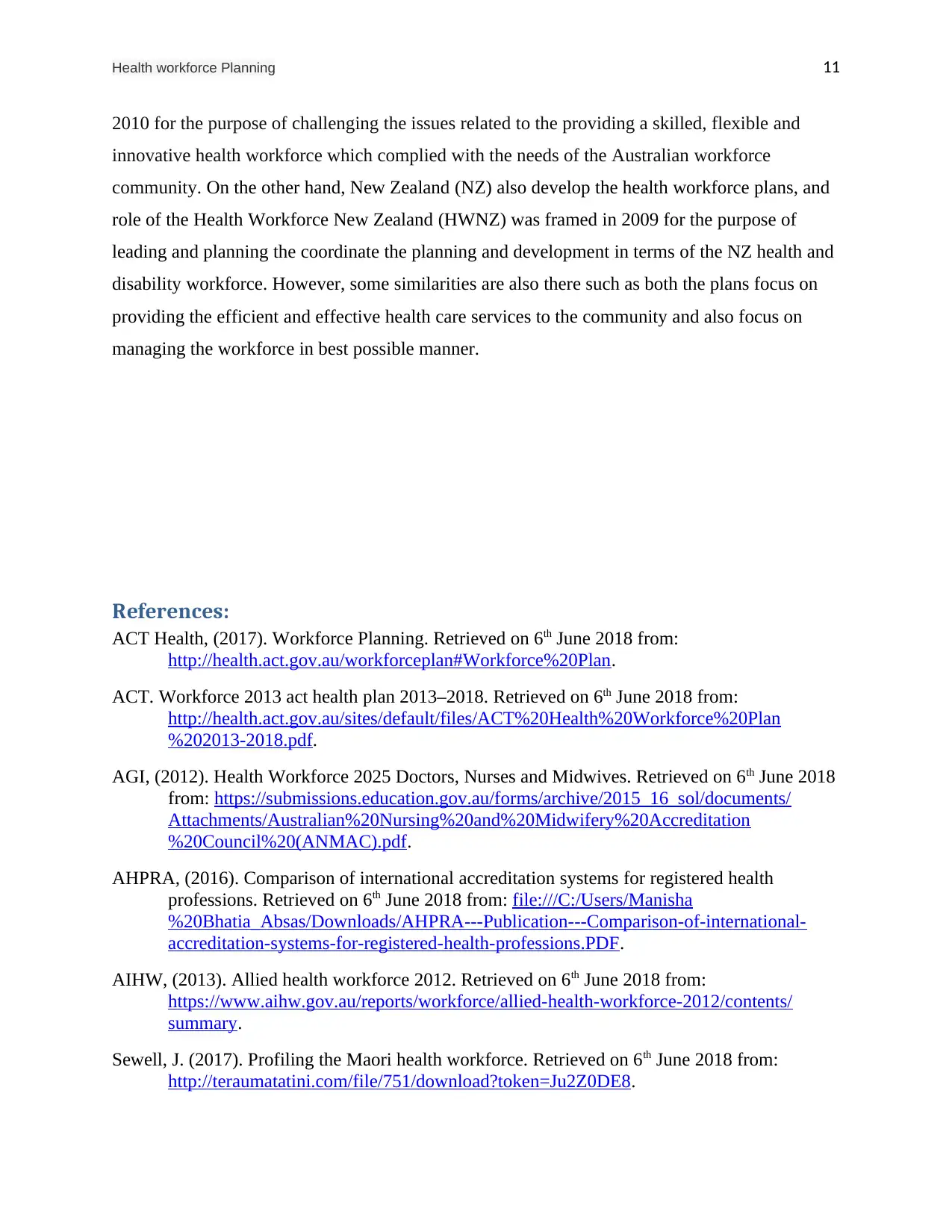
Health workforce Planning 11
2010 for the purpose of challenging the issues related to the providing a skilled, flexible and
innovative health workforce which complied with the needs of the Australian workforce
community. On the other hand, New Zealand (NZ) also develop the health workforce plans, and
role of the Health Workforce New Zealand (HWNZ) was framed in 2009 for the purpose of
leading and planning the coordinate the planning and development in terms of the NZ health and
disability workforce. However, some similarities are also there such as both the plans focus on
providing the efficient and effective health care services to the community and also focus on
managing the workforce in best possible manner.
References:
ACT Health, (2017). Workforce Planning. Retrieved on 6th June 2018 from:
http://health.act.gov.au/workforceplan#Workforce%20Plan.
ACT. Workforce 2013 act health plan 2013–2018. Retrieved on 6th June 2018 from:
http://health.act.gov.au/sites/default/files/ACT%20Health%20Workforce%20Plan
%202013-2018.pdf.
AGI, (2012). Health Workforce 2025 Doctors, Nurses and Midwives. Retrieved on 6th June 2018
from: https://submissions.education.gov.au/forms/archive/2015_16_sol/documents/
Attachments/Australian%20Nursing%20and%20Midwifery%20Accreditation
%20Council%20(ANMAC).pdf.
AHPRA, (2016). Comparison of international accreditation systems for registered health
professions. Retrieved on 6th June 2018 from: file:///C:/Users/Manisha
%20Bhatia_Absas/Downloads/AHPRA---Publication---Comparison-of-international-
accreditation-systems-for-registered-health-professions.PDF.
AIHW, (2013). Allied health workforce 2012. Retrieved on 6th June 2018 from:
https://www.aihw.gov.au/reports/workforce/allied-health-workforce-2012/contents/
summary.
Sewell, J. (2017). Profiling the Maori health workforce. Retrieved on 6th June 2018 from:
http://teraumatatini.com/file/751/download?token=Ju2Z0DE8.
2010 for the purpose of challenging the issues related to the providing a skilled, flexible and
innovative health workforce which complied with the needs of the Australian workforce
community. On the other hand, New Zealand (NZ) also develop the health workforce plans, and
role of the Health Workforce New Zealand (HWNZ) was framed in 2009 for the purpose of
leading and planning the coordinate the planning and development in terms of the NZ health and
disability workforce. However, some similarities are also there such as both the plans focus on
providing the efficient and effective health care services to the community and also focus on
managing the workforce in best possible manner.
References:
ACT Health, (2017). Workforce Planning. Retrieved on 6th June 2018 from:
http://health.act.gov.au/workforceplan#Workforce%20Plan.
ACT. Workforce 2013 act health plan 2013–2018. Retrieved on 6th June 2018 from:
http://health.act.gov.au/sites/default/files/ACT%20Health%20Workforce%20Plan
%202013-2018.pdf.
AGI, (2012). Health Workforce 2025 Doctors, Nurses and Midwives. Retrieved on 6th June 2018
from: https://submissions.education.gov.au/forms/archive/2015_16_sol/documents/
Attachments/Australian%20Nursing%20and%20Midwifery%20Accreditation
%20Council%20(ANMAC).pdf.
AHPRA, (2016). Comparison of international accreditation systems for registered health
professions. Retrieved on 6th June 2018 from: file:///C:/Users/Manisha
%20Bhatia_Absas/Downloads/AHPRA---Publication---Comparison-of-international-
accreditation-systems-for-registered-health-professions.PDF.
AIHW, (2013). Allied health workforce 2012. Retrieved on 6th June 2018 from:
https://www.aihw.gov.au/reports/workforce/allied-health-workforce-2012/contents/
summary.
Sewell, J. (2017). Profiling the Maori health workforce. Retrieved on 6th June 2018 from:
http://teraumatatini.com/file/751/download?token=Ju2Z0DE8.
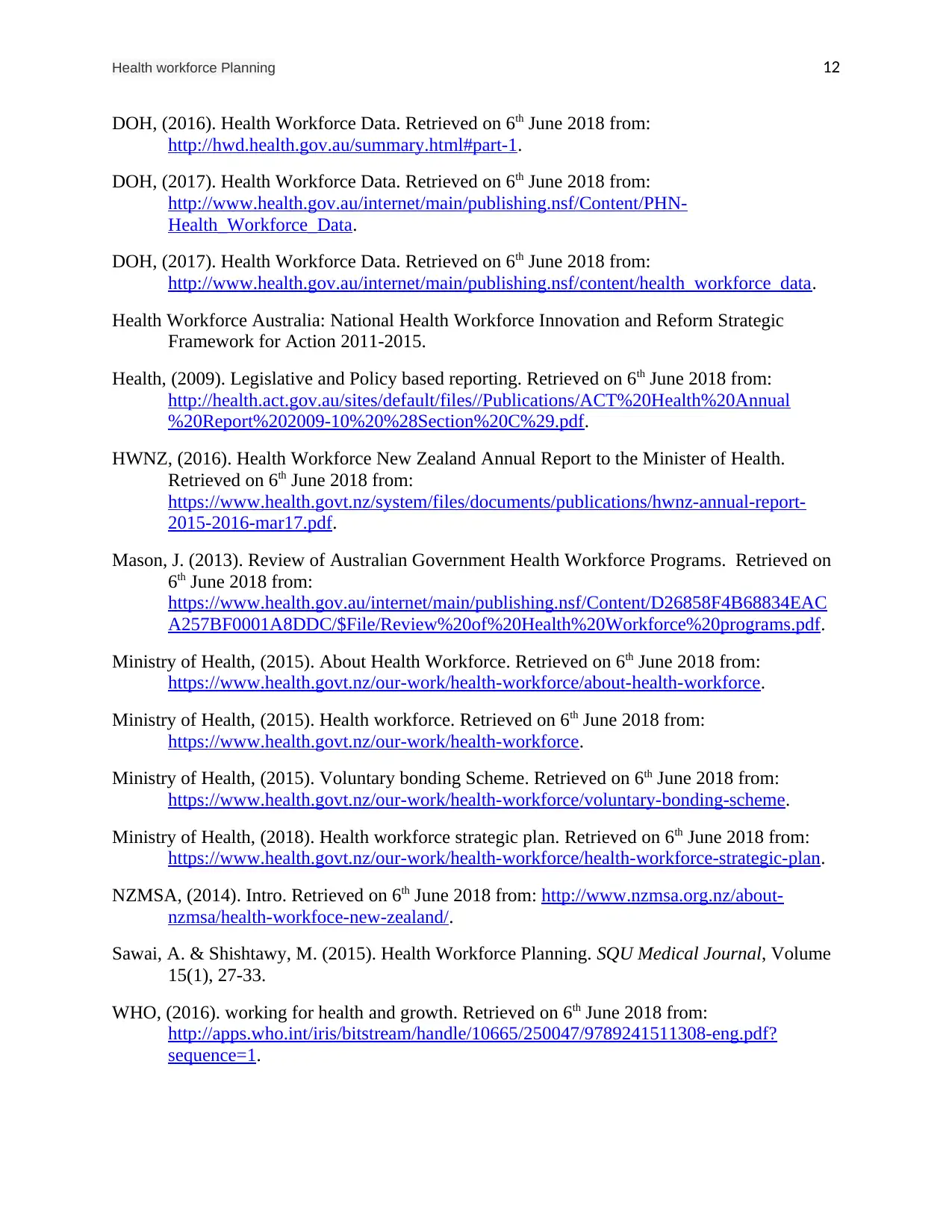
Health workforce Planning 12
DOH, (2016). Health Workforce Data. Retrieved on 6th June 2018 from:
http://hwd.health.gov.au/summary.html#part-1.
DOH, (2017). Health Workforce Data. Retrieved on 6th June 2018 from:
http://www.health.gov.au/internet/main/publishing.nsf/Content/PHN-
Health_Workforce_Data.
DOH, (2017). Health Workforce Data. Retrieved on 6th June 2018 from:
http://www.health.gov.au/internet/main/publishing.nsf/content/health_workforce_data.
Health Workforce Australia: National Health Workforce Innovation and Reform Strategic
Framework for Action 2011-2015.
Health, (2009). Legislative and Policy based reporting. Retrieved on 6th June 2018 from:
http://health.act.gov.au/sites/default/files//Publications/ACT%20Health%20Annual
%20Report%202009-10%20%28Section%20C%29.pdf.
HWNZ, (2016). Health Workforce New Zealand Annual Report to the Minister of Health.
Retrieved on 6th June 2018 from:
https://www.health.govt.nz/system/files/documents/publications/hwnz-annual-report-
2015-2016-mar17.pdf.
Mason, J. (2013). Review of Australian Government Health Workforce Programs. Retrieved on
6th June 2018 from:
https://www.health.gov.au/internet/main/publishing.nsf/Content/D26858F4B68834EAC
A257BF0001A8DDC/$File/Review%20of%20Health%20Workforce%20programs.pdf.
Ministry of Health, (2015). About Health Workforce. Retrieved on 6th June 2018 from:
https://www.health.govt.nz/our-work/health-workforce/about-health-workforce.
Ministry of Health, (2015). Health workforce. Retrieved on 6th June 2018 from:
https://www.health.govt.nz/our-work/health-workforce.
Ministry of Health, (2015). Voluntary bonding Scheme. Retrieved on 6th June 2018 from:
https://www.health.govt.nz/our-work/health-workforce/voluntary-bonding-scheme.
Ministry of Health, (2018). Health workforce strategic plan. Retrieved on 6th June 2018 from:
https://www.health.govt.nz/our-work/health-workforce/health-workforce-strategic-plan.
NZMSA, (2014). Intro. Retrieved on 6th June 2018 from: http://www.nzmsa.org.nz/about-
nzmsa/health-workfoce-new-zealand/.
Sawai, A. & Shishtawy, M. (2015). Health Workforce Planning. SQU Medical Journal, Volume
15(1), 27-33.
WHO, (2016). working for health and growth. Retrieved on 6th June 2018 from:
http://apps.who.int/iris/bitstream/handle/10665/250047/9789241511308-eng.pdf?
sequence=1.
DOH, (2016). Health Workforce Data. Retrieved on 6th June 2018 from:
http://hwd.health.gov.au/summary.html#part-1.
DOH, (2017). Health Workforce Data. Retrieved on 6th June 2018 from:
http://www.health.gov.au/internet/main/publishing.nsf/Content/PHN-
Health_Workforce_Data.
DOH, (2017). Health Workforce Data. Retrieved on 6th June 2018 from:
http://www.health.gov.au/internet/main/publishing.nsf/content/health_workforce_data.
Health Workforce Australia: National Health Workforce Innovation and Reform Strategic
Framework for Action 2011-2015.
Health, (2009). Legislative and Policy based reporting. Retrieved on 6th June 2018 from:
http://health.act.gov.au/sites/default/files//Publications/ACT%20Health%20Annual
%20Report%202009-10%20%28Section%20C%29.pdf.
HWNZ, (2016). Health Workforce New Zealand Annual Report to the Minister of Health.
Retrieved on 6th June 2018 from:
https://www.health.govt.nz/system/files/documents/publications/hwnz-annual-report-
2015-2016-mar17.pdf.
Mason, J. (2013). Review of Australian Government Health Workforce Programs. Retrieved on
6th June 2018 from:
https://www.health.gov.au/internet/main/publishing.nsf/Content/D26858F4B68834EAC
A257BF0001A8DDC/$File/Review%20of%20Health%20Workforce%20programs.pdf.
Ministry of Health, (2015). About Health Workforce. Retrieved on 6th June 2018 from:
https://www.health.govt.nz/our-work/health-workforce/about-health-workforce.
Ministry of Health, (2015). Health workforce. Retrieved on 6th June 2018 from:
https://www.health.govt.nz/our-work/health-workforce.
Ministry of Health, (2015). Voluntary bonding Scheme. Retrieved on 6th June 2018 from:
https://www.health.govt.nz/our-work/health-workforce/voluntary-bonding-scheme.
Ministry of Health, (2018). Health workforce strategic plan. Retrieved on 6th June 2018 from:
https://www.health.govt.nz/our-work/health-workforce/health-workforce-strategic-plan.
NZMSA, (2014). Intro. Retrieved on 6th June 2018 from: http://www.nzmsa.org.nz/about-
nzmsa/health-workfoce-new-zealand/.
Sawai, A. & Shishtawy, M. (2015). Health Workforce Planning. SQU Medical Journal, Volume
15(1), 27-33.
WHO, (2016). working for health and growth. Retrieved on 6th June 2018 from:
http://apps.who.int/iris/bitstream/handle/10665/250047/9789241511308-eng.pdf?
sequence=1.
⊘ This is a preview!⊘
Do you want full access?
Subscribe today to unlock all pages.

Trusted by 1+ million students worldwide
1 out of 13
Related Documents
Your All-in-One AI-Powered Toolkit for Academic Success.
+13062052269
info@desklib.com
Available 24*7 on WhatsApp / Email
![[object Object]](/_next/static/media/star-bottom.7253800d.svg)
Unlock your academic potential
Copyright © 2020–2025 A2Z Services. All Rights Reserved. Developed and managed by ZUCOL.





